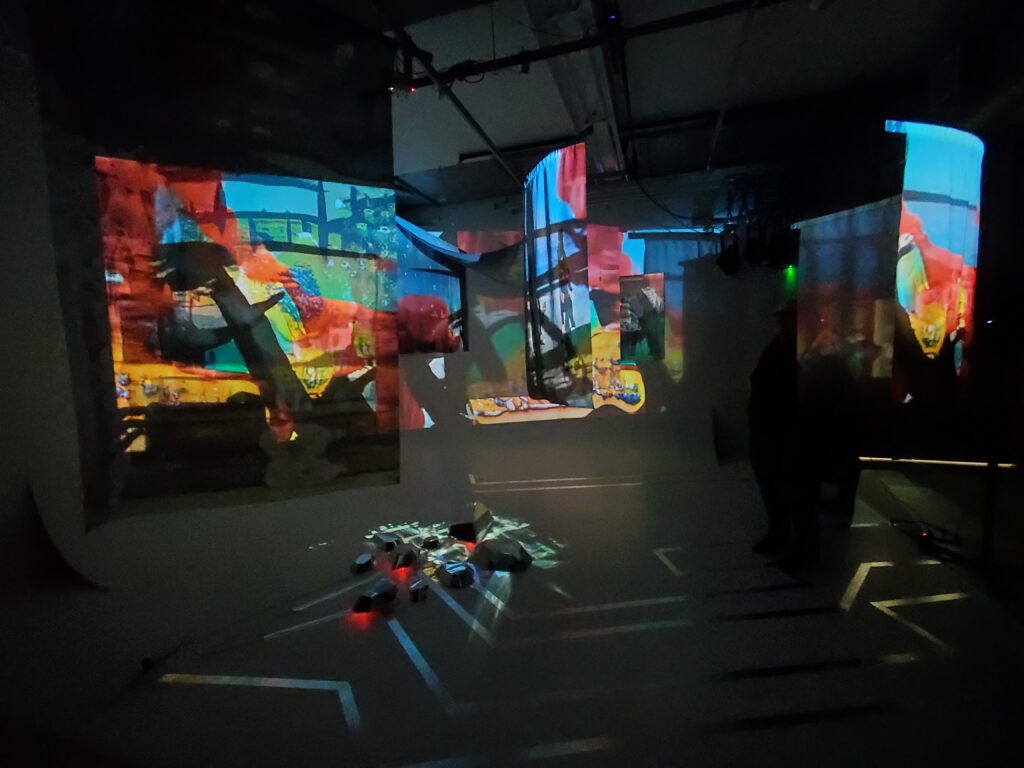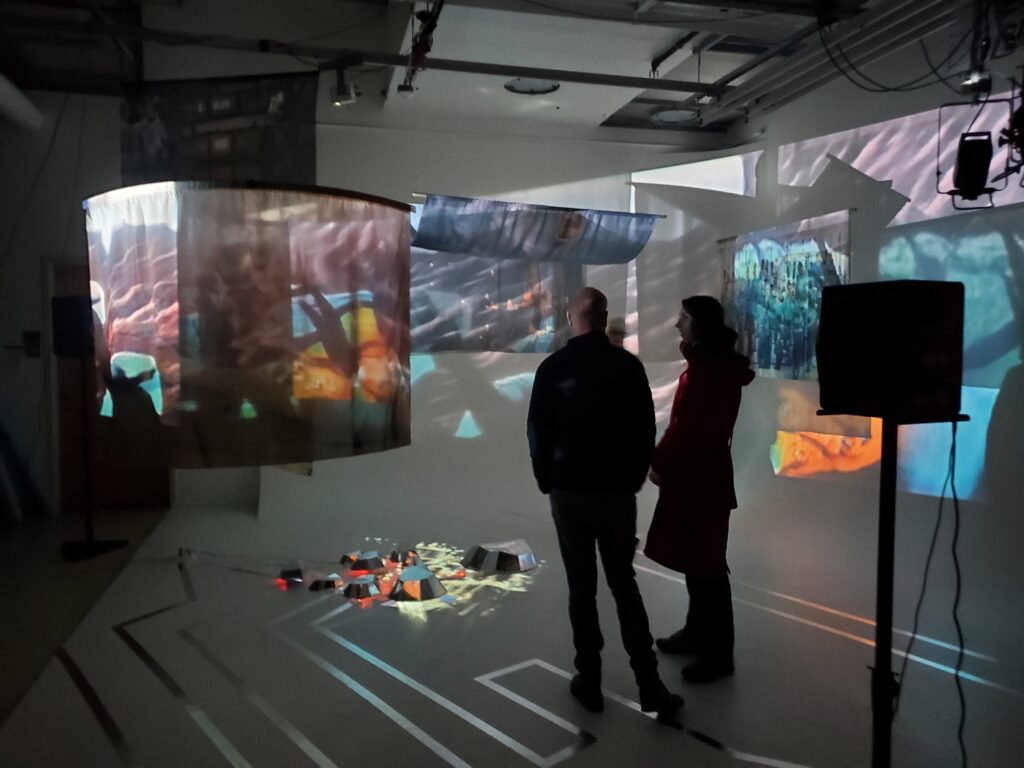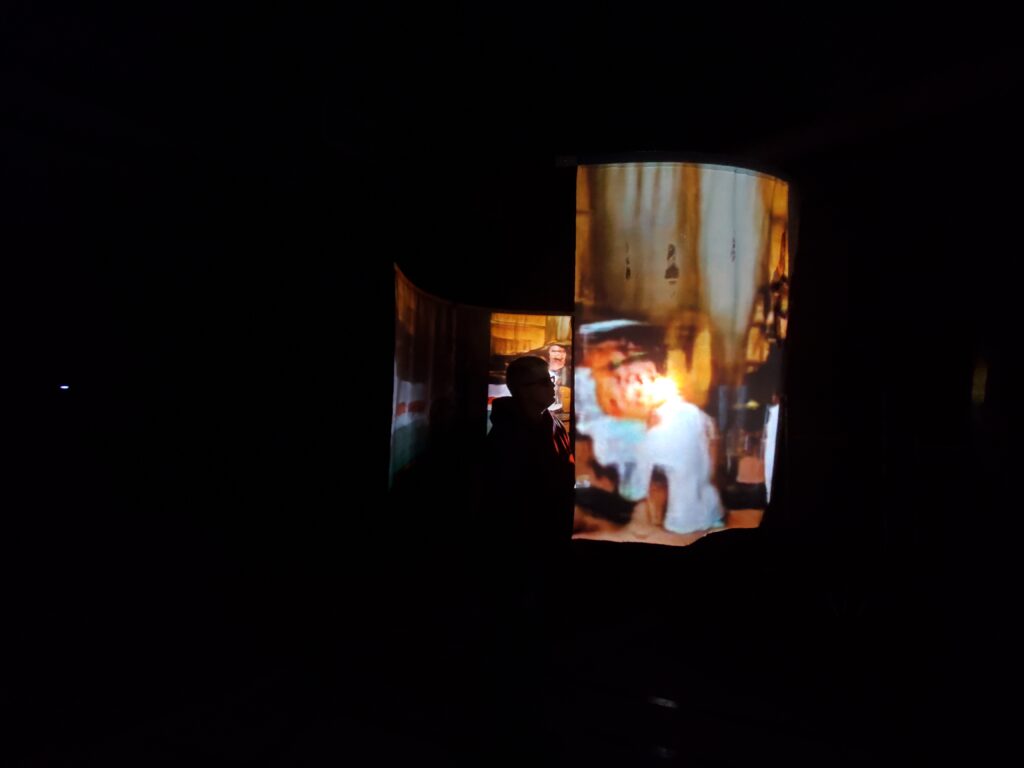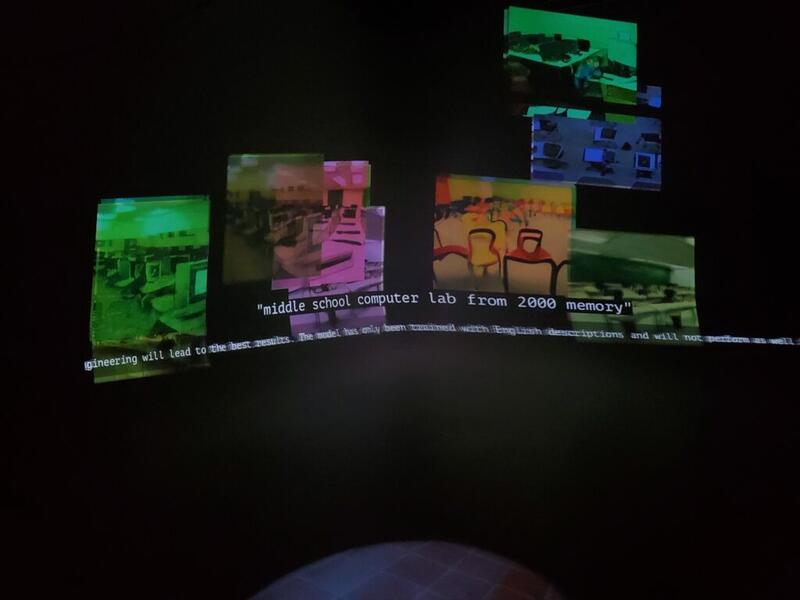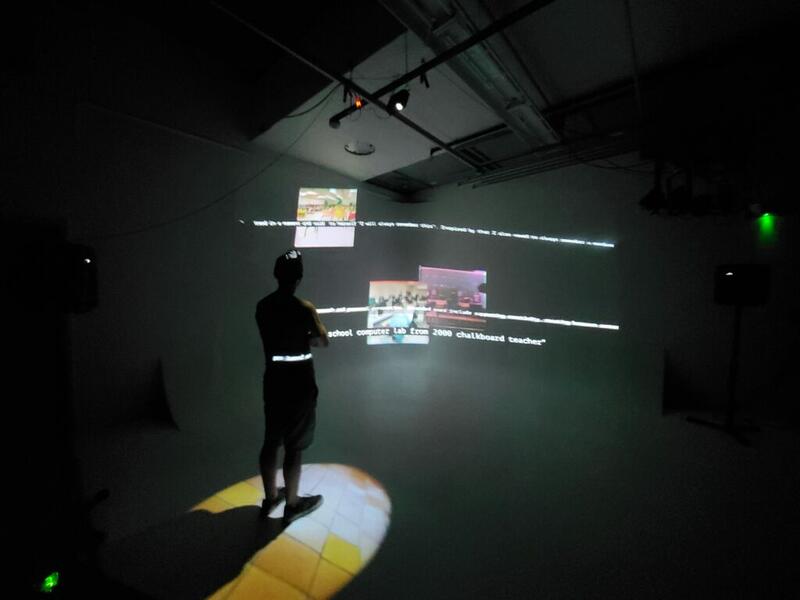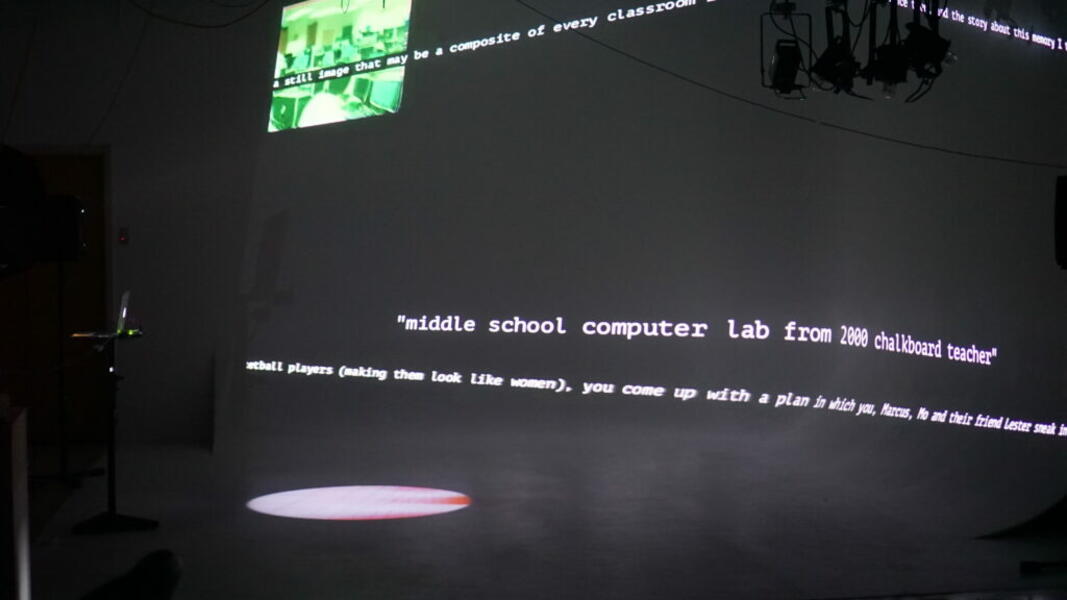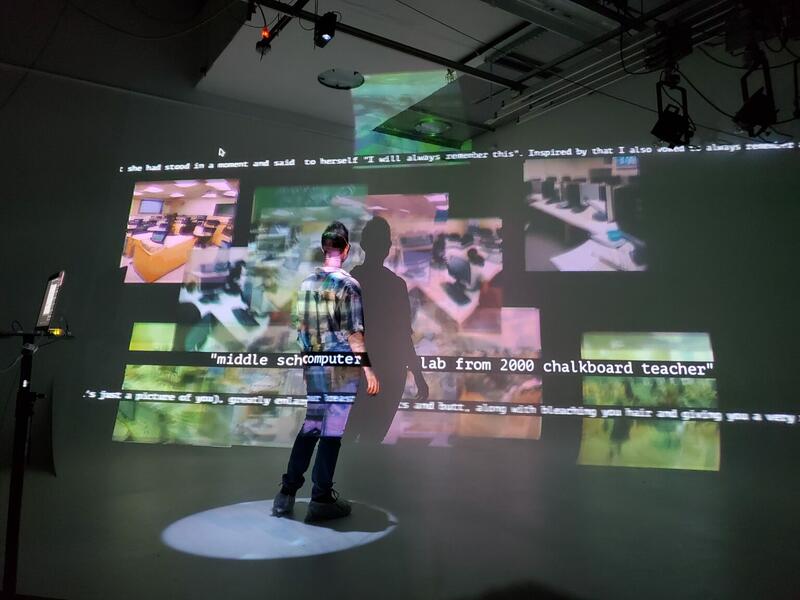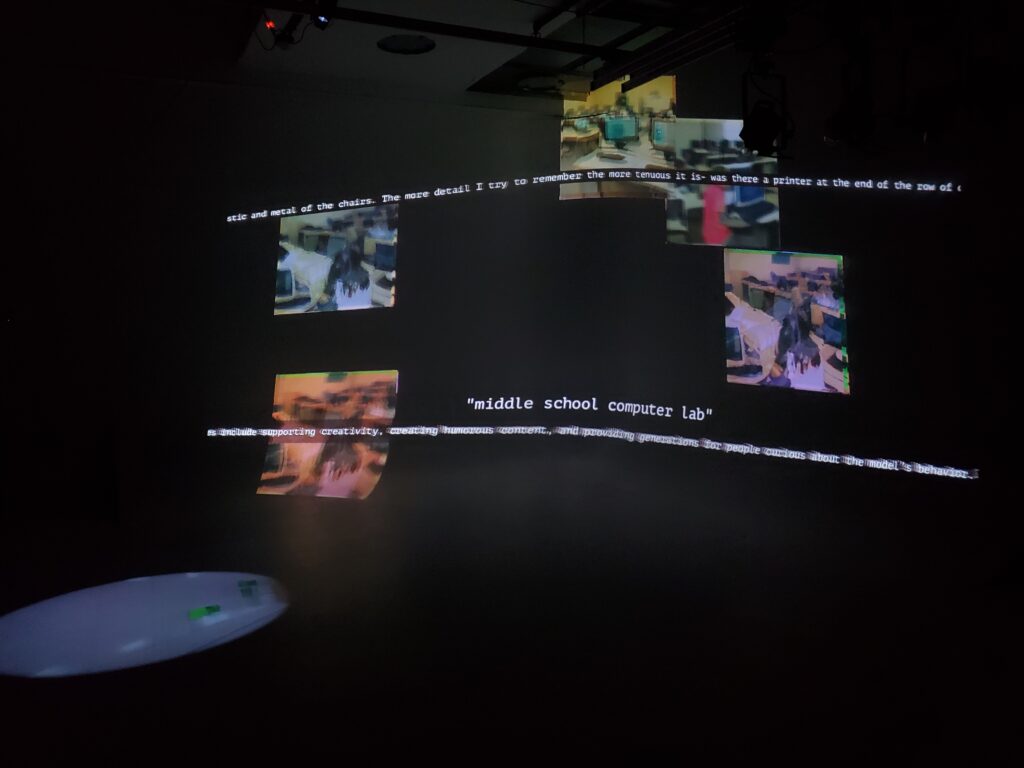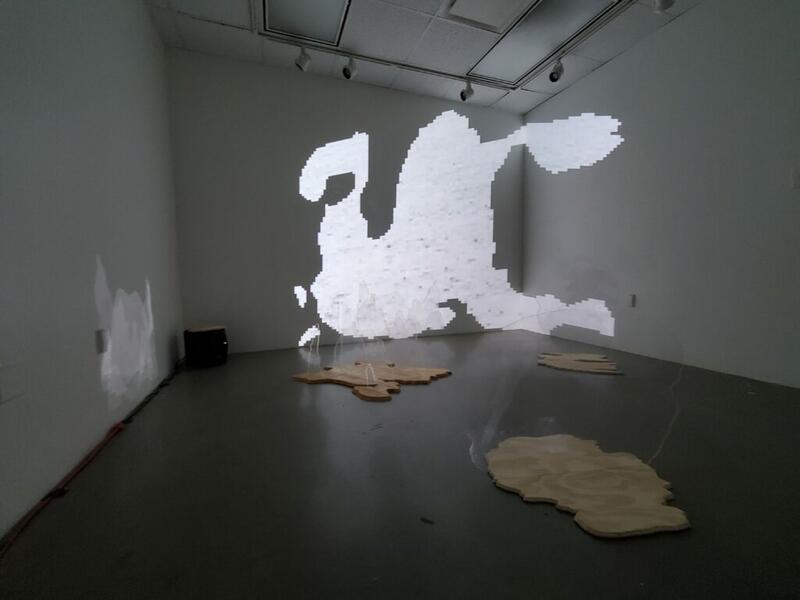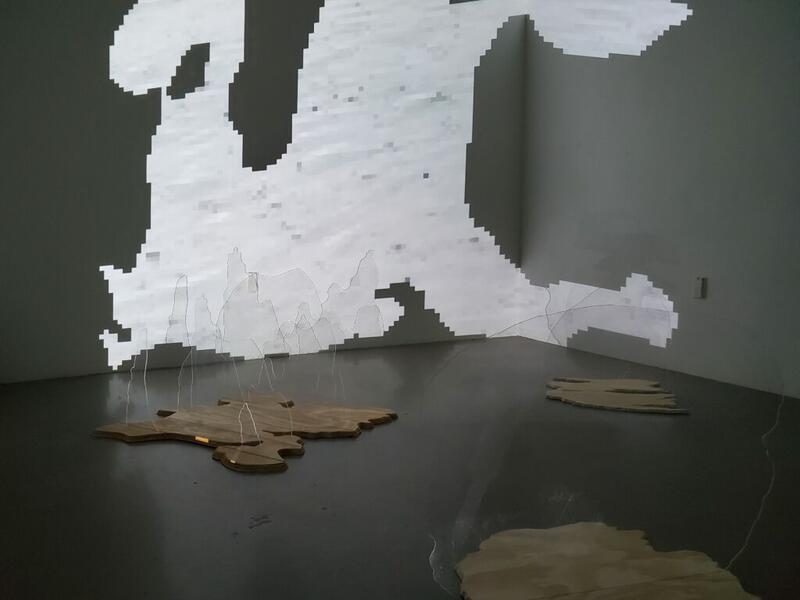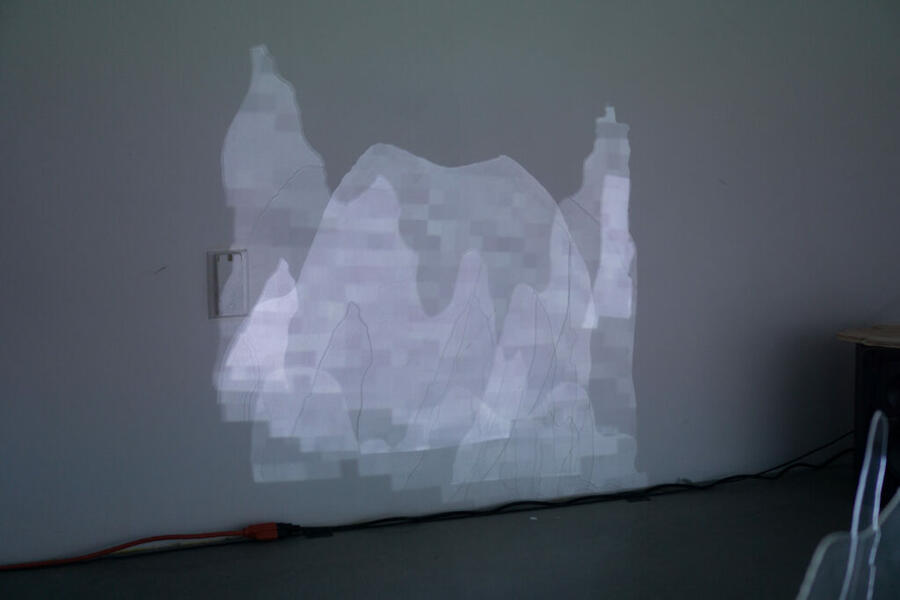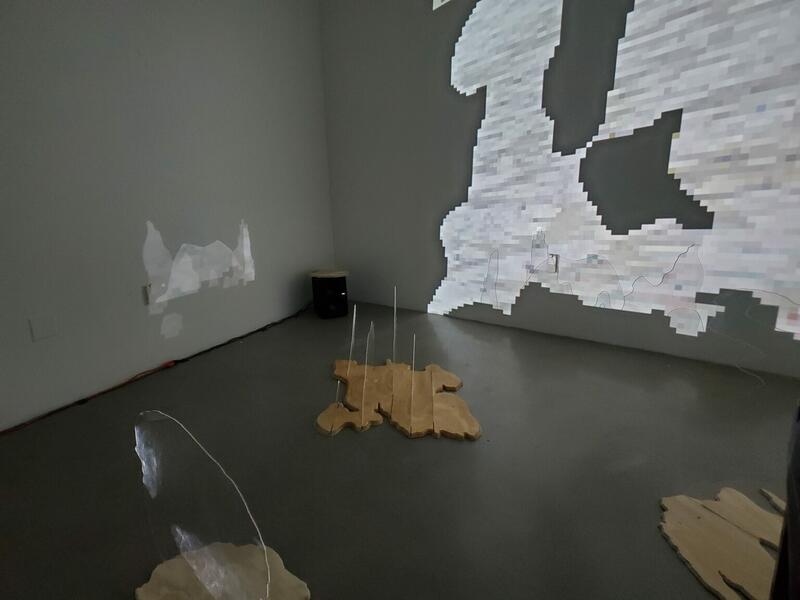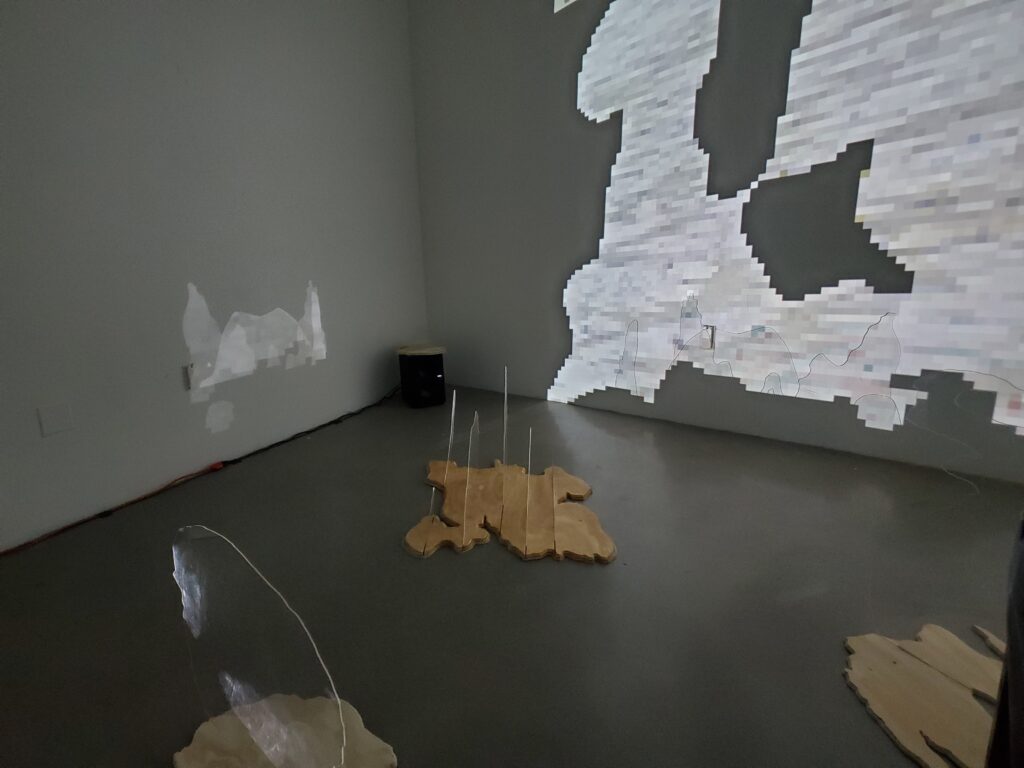Work samples
-
not a town but a landing page
not a town but a landing page, 2025. Projected video, mesh fabric, ethernet cords, yarn, wire, plexiglass, outlet plates, two-channel sound. 132” x 119” x 203”.
The New Castle and Frenchtown Railroad (NCFRR) was one of the first railroads in the United States. The railroad only operated for 28 years; as newer, more direct railways were built, the New Castle and Frenchtown Railroad was abandoned, and then without a commercial artery, the town of Frenchtown was also deserted. This obsolescence of the railroad and town is analogous to digital technological loss in its root in the movement of capital and technological change. In this project, I use the archive in conjunction with contemporary data to try and recreate a ghost without its community. In the process of this re-creation, I use techniques of glitch, loss, and layering to question the role of data, archives, and recreation in understanding place, loss and memory.
-
datastream (Minebank Run)
datastream (Minebank Run). Multi channel video, digital sound, mylar, cyanotype, etched plexiglass. 12’ x 13’ installation, 2024.
In this ongoing project, I am interested in creating a portrait of a site (Minebank Run in Parkville, Maryland), and the ways in which we can know a space through data, and the many ways through which data-driven ways of knowing will fail us. There is a contemporary inclination to assume we can truly know things (ourselves, the natural environment, economic trends, image-making techniques) through machine learning or traditional mathematical algorithms. However, these data-driven models don’t accurately model out projections or create understanding, but instead create a compressed average of the data provided.
-
Analytical Engine RAM
Analytical Engine RAM, 2023. Digital prints on chiffon, 2-channel digital projection, 4-channel sound, mylar and rotating stands, foil tape. Variable dimensions.
-
thanks for the 128kbps memories
ai image generator prompt generator, companion website to installation: http://tarayoungborg.com/ai_image_generator_prompt_generator/
Medium: Two channel projection, four-channel sound, arduino infrared sensor
Year: 2022
About Tara
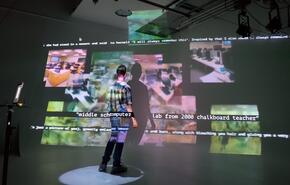
Tara Youngborg is a Maryland-based artist, educator, curator, and arts administrator. She has a B.A. in Art and Art History from St Mary's College of Maryland an MFA in Studio Art from Towson University. Her work uses digital media to create immersive video and audio installations that explore place, memory, and technology. She is also the manager of the Stamp Gallery at the University of Maryland, College Park, where she directs the exhibition programming and advises the Contemporary… more
not a town but a landing page
The New Castle and Frenchtown Railroad (NCFRR) was one of the first railroads in the United States. The railroad only operated for 28 years; as newer, more direct railways were built, the New Castle and Frenchtown Railroad was abandoned, and then without a commercial artery, the town of Frenchtown was also deserted. This obsolescence of the railroad and town is analogous to digital technological loss in its root in the movement of capital and technological change. In this project, I use the archive in conjunction with contemporary data to try and recreate a ghost without its community. In the process of this re-creation, I use techniques of glitch, loss, and layering to question the role of data, archives, and recreation in understanding place, loss and memory.
-
not a town but a landing page - Iterating down the tracks installation
-
 not a town but a landing page installation
not a town but a landing page installation -
 not a town but a landing page installation
not a town but a landing page installation -
 not a town but a landing page installation
not a town but a landing page installation -
 not a town but a landing page installation
not a town but a landing page installation -
 not a town but a landing page installation
not a town but a landing page installation -
 not a town but a landing page installation
not a town but a landing page installation -
 not a town but a landing page installation
not a town but a landing page installation -
not a town but a landing page - Feedback Loop (Bear, Delaware Relay Station) installation
-
not a town but a landing page - A word about early days installation
datastream (Minebank Run)
datastream (Minebank Run). Multi channel video, digital sound, mylar, cyanotype, etched plexiglass. 12’ x 13’ installation, 2024.
In this ongoing project, I am interested in creating a portrait of a site (Minebank Run in Parkville, Maryland), and the ways in which we can know a space through data, and the many ways through which data-driven ways of knowing will fail us. There is a contemporary inclination to assume we can truly know things (ourselves, the natural environment, economic trends, image-making techniques) through machine learning or traditional mathematical algorithms. However, these data-driven models don’t accurately model out projections or create understanding, but instead create a compressed average of the data provided.
I am using data from the US Geological Survey, satellite imagery, 3D scans, and data sourced from other governmental agencies, ostensibly to illustrate this site, but ultimately to complicate the idea that we can use data to fully understand the more-than-human world. The data, and digital media more broadly, is overlaid on the physical environment as a fourth dimension, expanding our sense of time and space from the physical now to the past, future, and far-flung.
When I visit a place I will often document it or learn about it though online listing and ephemera left by others- I’m trying to control it through understanding and visual data, making it knowable. These recordings are a means of control, but the display, along with the data displayed, slips through our ability to fully control and understand the many elements in this site.
-
datastream (Minebank Run) installation documentation
-
 datastream (Minebank Run) installation view
datastream (Minebank Run) installation view -
 datastream (Minebank Run) installation view
datastream (Minebank Run) installation view -
 datastream (Minebank Run) installation view
datastream (Minebank Run) installation view -
 datastream (Minebank Run) installation view
datastream (Minebank Run) installation view -
 datastream (Minebank Run) video still
datastream (Minebank Run) video still -
Youngborg, Tara - datastream (minebank run)
Analytical Engine RAM
Analytical Engine RAM, 2023. Digital prints on chiffon, 2-channel digital projection, 4-channel sound, mylar and rotating stands, foil tape. Variable dimensions.
I am interested in how our brains distort memories through neuroscientific processes, and the ways in which our technologies can mirror these human glitches and failures. I use a variety of visual distortions to relate to the distortion of our memories, becoming recontextualized as part of our repeated recollections.
This installation consists of projected, morphing abstract imagery, digital prints of these abstracted images on chiffon, mylar sculptures, an abstract soundscape made from the color data of the video, as well as the audio interpretations of the images by humans and artificial intelligence algorithms1.
For this project, I have trained a neural network, a type of artificial intelligence (AI) algorithm, on a set of images from my past to try and create new memories, shared between myself and my AI. I then used the images that were created from my dataset as training data for the neural network, in order to create a feedback loop to enhance the qualities inherent to the visual qualities created by the model.
I am also considering the tendency towards building our technology to mimic human experience– such as the ways we look to nature for pattern making (ie, using fibonacci numbers to create patterns in code, calling randomized numbers ”seeds” for our programs). The neural network that trained to generate these images uses a randomized noise field (which looks like static on a television screen) as the underlying structure for the image, and then draws out the images it generates through a machinic apophenia2, creating unnatural, blobby animations that look not natural, but have a wide possibility of interpretations.
Our embodied experience extends into the fourth dimension– a space expanded through our experience of time and virtuality through the internet.3 This is also what I am trying to create and consider: the spaces we experience when looking at a digital screen, and the spaces that we cannot see within the computer programs, and how we consider and interpret the past when situated in a different temporal and physical space.
1: An algorithm is a program that consists of a set of rules to solve a specific mathematical or other type of problem. Algorithms are still the base of all of our computer models, and the goal of how we approach computation- as problems to come to a concrete solution.
2: Apophenia: the tendency to perceive a connection or meaningful pattern between unrelated or random things (such as objects or ideas) (Merriam-Webster)
3: Laurence Scott, The Four-Dimensional Human
-
 Analytical Engine RAM at the Carver Center
Analytical Engine RAM at the Carver Center -
 Analytical Engine RAM Installation View
Analytical Engine RAM Installation View -
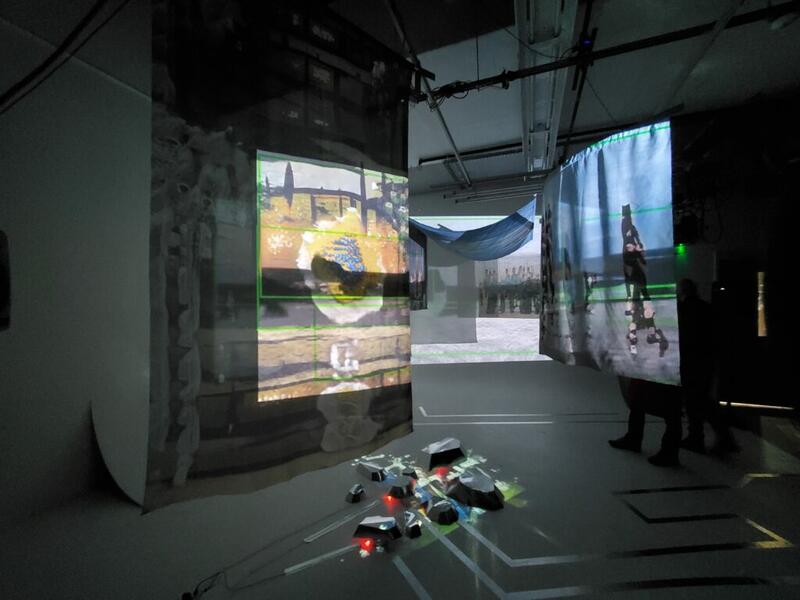 Analytical Engine RAM Installation View
Analytical Engine RAM Installation View -
 Analytical Engine RAM Installation View
Analytical Engine RAM Installation View -
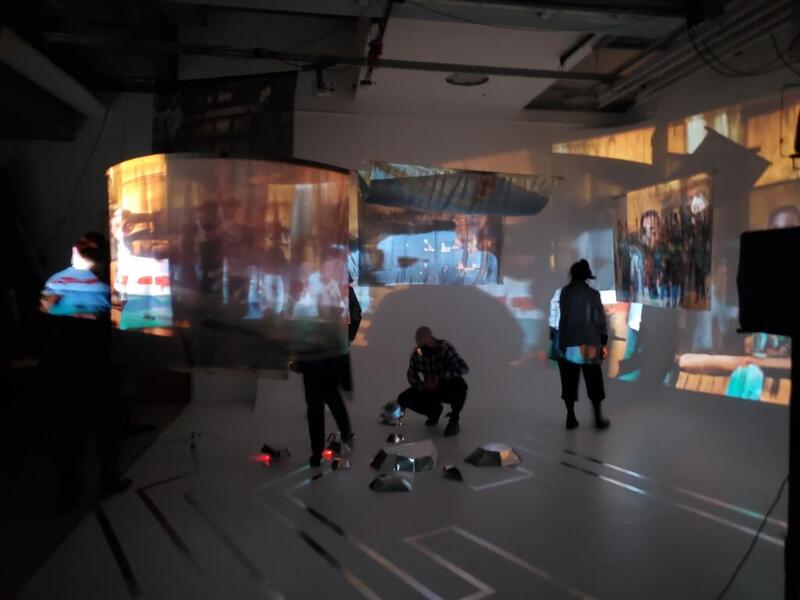 Analytical Engine RAM Installation View
Analytical Engine RAM Installation View -
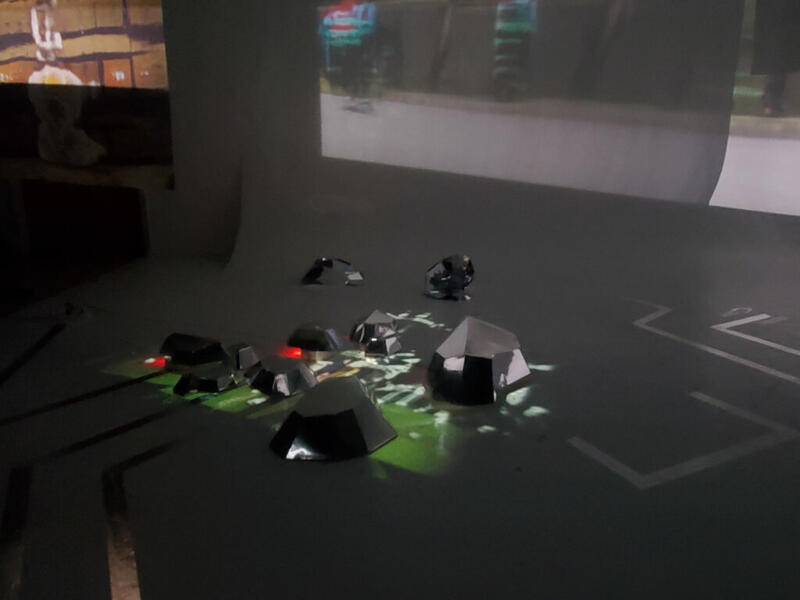 Analytical Engine RAM Installation View
Analytical Engine RAM Installation View -
 Analytical Engine RAM Installation View
Analytical Engine RAM Installation View -
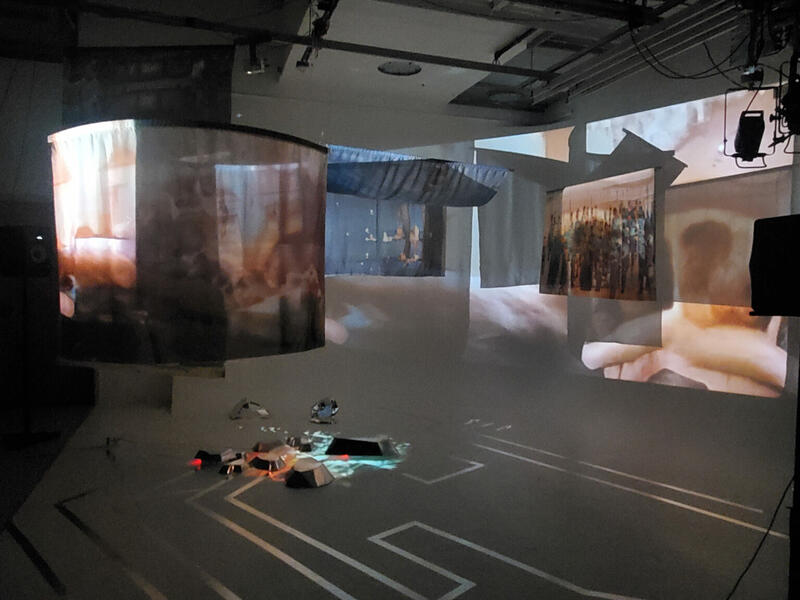 Analytical Engine RAM Installation View
Analytical Engine RAM Installation View -
Analytical Engine RAM at Towson University
-
Analytical Engine RAM at the Carver Center
thanks for the 128kbps memories
thanks for the 128kbps memories is an immersive installation that utilizes glitch aesthetics and computer-generated imagery to reference, create, and highlight how tenuous the connections of memory are. This piece used images created by a text-to-image AI generator based on prompts from my most recalled memory. However, these images can only reflect the content, biases, and assumptions of the source dataset in a loop of endlessly recreating the world as it is depicted. I am interested in how this reflects the neuroscientific process through which the human brain overwrites a memory each time it has to recall that memory. We are all in loops of our own design, rewriting and reinscribing our own systems and memories. The image and prompt pairs were projected in the installation, appearing when triggered by an Arduino-controlled infrared sensor that also distorted the generated imagery. I composed a soundscape and written narrative as part of the installation as well.
This piece includes a companion website to installation: ai image generator prompt generator, http://tarayoungborg.com/ai_image_generator_prompt_generator/
Confluence
In this piece I created a reference to water, memory, and glitch that is rooted in my personal experiences, but distorted and glitched through the process of recollection. This installation consisted of three floor pieces- plexiglass bodies of water enmeshed in wooden coastlines. The plexiglass reflected light and moving images around the room from the projected imagery that consists of a program written to glitch and pixelate videos of water from various coastal locations. Accompanying the sculptures and code is an audio piece that includes a narrative I have written about water and my memory.
Web and Video Pieces
-
 notatownbutalandingpage.com
notatownbutalandingpage.comnotatownbutalandingpage.com, 2025. Web site.
-
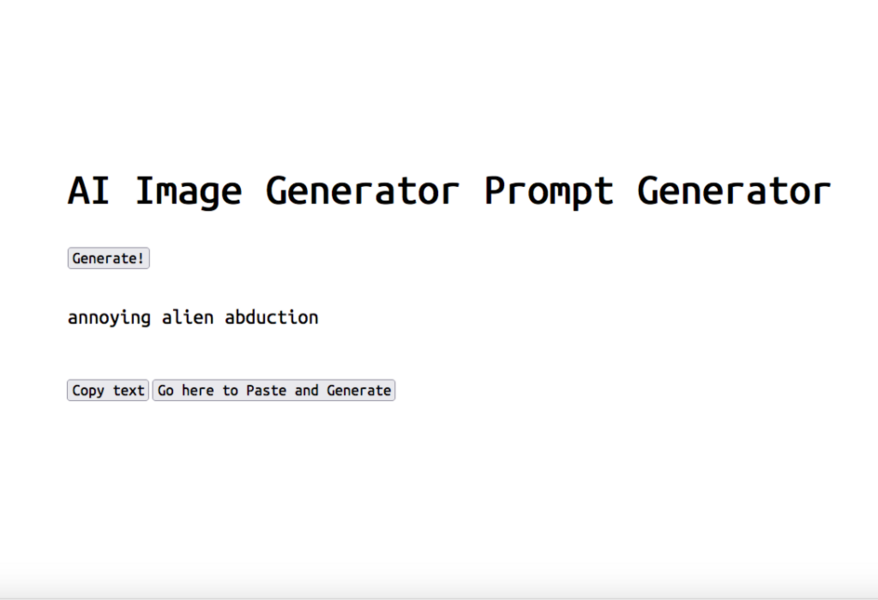 ai image generator prompt generator
ai image generator prompt generatorai image generator prompt generator, companion website to thanks for the 128kbps memories installation: http://tarayoungborg.com/ai_image_generator_prompt_generator/
-
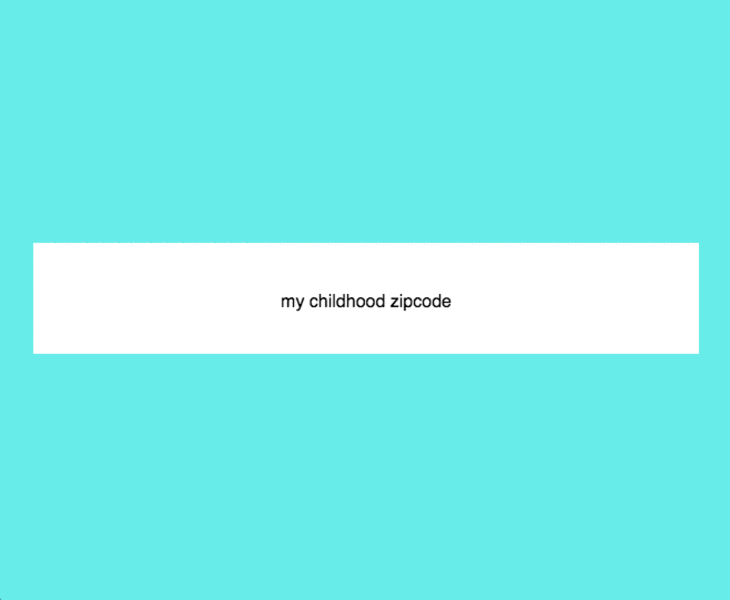 random number generator
random number generator -
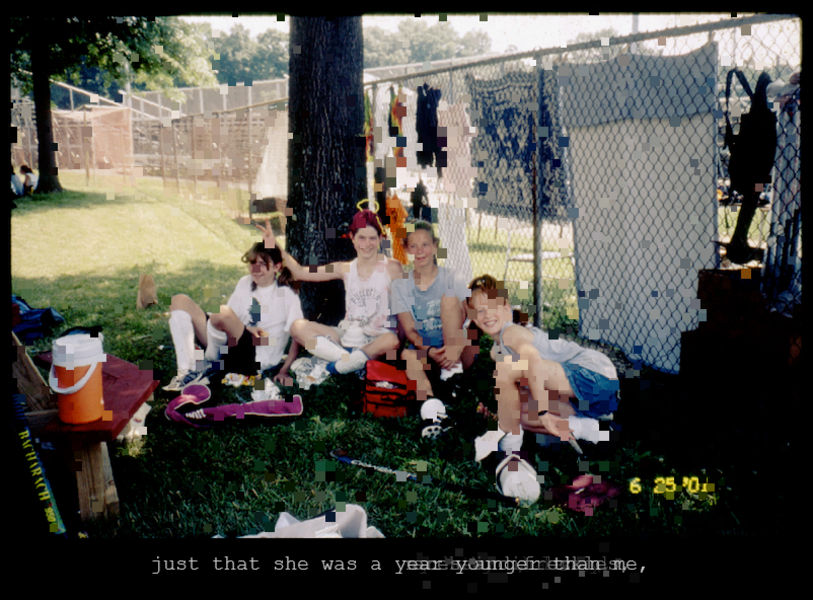 defense mechanism
defense mechanismCommission for Alastria Press, Can be viewed at http://tarayoungborg.com/defense_mechanism/
-
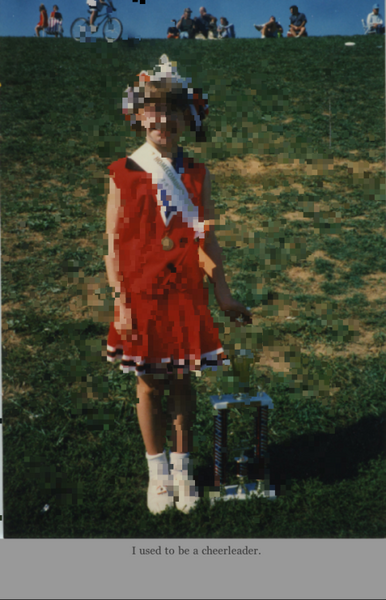 i used to be a cheerleader
i used to be a cheerleader -
 ourfuturechildren
ourfuturechildrenourfuturechildren is a series of web and video pieces created as part of #cyborgs by Peripheral Forms. It can be accessed at http://tarayoungborg.com/ourfuturechildren/
As a lesbian married to another cis woman, I am both forced into and eager to take on the role of a cyborg-woman. Whenever I talk about the possibility of having children, straight people immediately ask us about our conception, or if we will adopt. Our reproduction and families are immediately placed under scrutiny, despite the high number of straight couples that use IUI or IVF or adoption alongside their queer brethren. When straight couples use IVF, it is because they can't conceive "naturally”— what a loaded, and telling, word.
There is a tension inside of me where I do not want my hypothetical future family to be seen as the ‘other’, but I also do not want to be a part of the heterosexual hegemony or social norms. I am grateful to and welcome the use these technologies to create our future children — and I wish they could go further, I want to envision the image of my future technology-conceived daughter.
ourfuturechildren is a series of interactive web pieces and videos around birthing.
Tara's mother had a dream while she was pregnant with her about birthing a squirrel and thus feels like a #cyborg from birth.
outfuturechildren uses pixelated versions of found images from the artists childhood as a way of imaging her future children.
-
a box, a room, a closet














